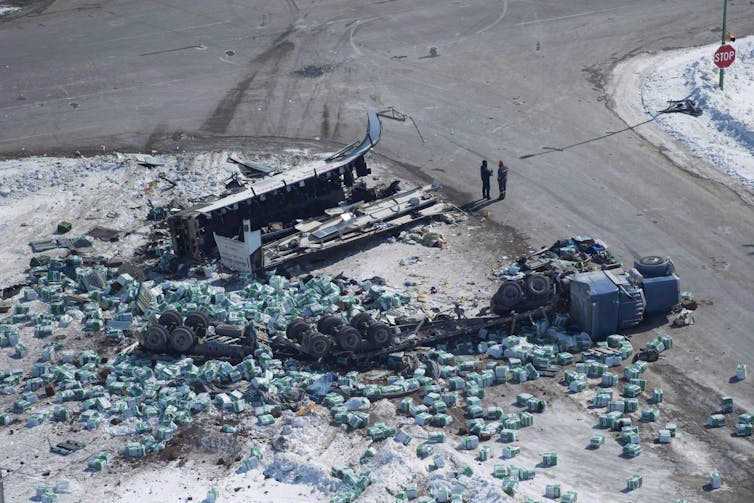The legalization of cannabis in Canada has sparked discussion about workplace and driver impairment, but what about other forms of on-the-job impairment?

As we debate the impact of marijuana in the workplace, it’s a perfect time to examine a wide range of current policies and practices that promote worker fatigue and distraction, while also finding ways to design safer workplaces that minimize or eliminate human error.
READ MORE: Sleepy drivers get wake-up call with new impairment suit
Employers and those developing public policy are quite rightly concerned about the impacts of marijuana in the workplace, given the lack of expert agreement about what levels of marijuana in the body create impairment and the lack of an easy-to-administer test.
While experts search for a reliable test for marijuana impairment, let’s remember that alcohol and drugs are not the only sources of impairment.
Grief, illness and other impairments
Grief, mental and physical illnesses, stress, fatigue, prescription and non-prescription medication, migraines and even severe allergies can impair human performance. The recent elimination of personal sick days by the Ontario government will lead to more people on the roads and at work who should be home in bed.
While there is a wide difference of performance between an out-of-control drunk driver and one with the flu or severe fatigue, clearly neither is functioning optimally. Research has shown that fatigue causes performance declines on par with alcohol use.
- RCMP arrests alleged hitmen accused of killing B.C. Sikh leader
- Fall COVID-19 vaccine guidelines are out. Here’s what NACI recommends
- Some 2019 candidates ‘appeared willing’ to engage with foreign interference: Hogue inquiry
- Thousands of Canada’s rail workers have a strike mandate. What happens now?
As a society, how do we make sure all workers can be safe, given the variety of impairments and other societal and workplace hazards?“
Clearly, we need to prevent those who are impaired beyond a certain point from getting behind the wheel of a vehicle or performing safety-sensitive occupations. But there are less-severe degrees of impairment caused by other issues, so we should also focus on reducing the potential for human error through improved design.
READ MORE: Sask. employers can soon use software to detect workplace fatigue and impairment
‘Human error’ shouldn’t absolve designers
Calling the cause of an accident “human error” puts the blame on the individual and absolves the designers from responsibility for error-prone designs. Errors occur as much due to system design as to the limitations we all have as humans. So “human-system error” is a more accurate description of these events.
But it’s not just workplace policies that increase risks. As technology companies insert huge TV screens into cars, designers are moving in the opposite direction of increased safety. They are creating more complex interfaces and bombarding drivers with more information, likely increasing reaction times with more controls to choose from.
Until engineers learn to design resilient systems that are suited to humans and human limitations, people will continue to be injured and killed due to entirely avoidable human-system errors.

How do we prevent those errors from reoccurring? Modifications in transportation systems could reduce the scope for human error. A high-profile recent example is the terrible bus-truck crash in 2018 that killed members of the Humboldt Broncos hockey team — an accident that happened at the same site of previous collisions.
READ MORE: Truck driver in Humboldt Broncos bus crash sentenced to eight years
Changes come after tragedies, not before
Yes, human error was a key factor, but as a result there will be design changes such as improved visibility and rumble strips to try and minimize the potential for a reoccurrence. But why aren’t such improvements made before tragic human-system errors occur?
To prevent “human error” here are some practical solutions to support the design of safe, fault-tolerant systems:
● Engineers not only need to be trained in safety engineering, but they must have a better understanding of how people use equipment or systems. This training on human capability and limitations is largely absent in our engineering training programs.
● Management schools need to develop leaders who understand the value of resilient systems designed to support human capability, rather than test its limits.
● Employers need to be aware of the fatigue-related impairments their workplace practices (workload and work schedules) may impose on employees.
● Workers need to be aware of their own limitations and factors that might be impairing their performance — let’s be careful out there!
Ideally, everyone who drives a vehicle or shows up for work is at peak performance. Recognizing that the reality might sometimes be less than ideal, let’s use the current discussion about marijuana impairment to rethink overall workplace and transportation design.Peggy Nash, Senior Advisor, Centre for Labour Management Relations, Ted Rogers School of Management, Ryerson University, Ryerson University and Patrick Neumann, Professor, Department of Mechanical and Industrial Engineering, Ryerson University
This article is republished from The Conversation under a Creative Commons license. Read the original article.



Comments